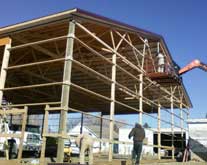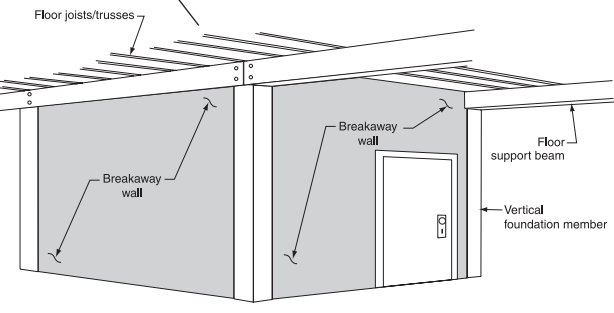Welcome to Ask the Pole Barn Guru – where you can ask questions about building topics, with answers posted on Mondays. With many questions to answer, please be patient to watch for yours to come up on a future Monday segment. If you want a quick answer, please be sure to answer with a “reply-able” email address.
Email all questions to: PoleBarnGuru@HansenPoleBuildings.com
DEAR POLE BARN GURU: Should I go with wood, or 12 or 14 gauge steel trusses? DELIBERATING DEE
DEAR DELIBERATING: I came from the prefabricated wood roof truss industry, having spent nearly two decades either having built them myself, been a designer, managing or owning roof truss manufacturing plants.
In my experience I learned prefabricated wood trusses are amazing products. Not only can they be utilized for a myriad of different application, they also are a highly engineered product. Every component of a wood roof truss is put through a rigorous computer analysis, which verifies all members are capable (when properly installed and braced) to be able to withstand not only the snow loads to which they will be subjected, but also wind loads. The entire process is remarkably complex, involving the most up-to-date research available. Because of this, wood roof trusses just do not experience failures, within the parameters of the design loads.
Besides all of this, pre-fabricated roof truss manufacturers are required, by the Building Codes, to be inspected quarterly by an independent firm for quality control. These inspections are done without any advance notice – the inspector just shows up unannounced. The truss company must supply the engineer sealed drawings for every truss the inspector wants to review. No engineering and the trusses must be destroyed. The inspectors are so thorough, they even take a micrometer to the steel roof truss plates, to confirm they are the correct thickness! The size and grade of every piece of wood in the truss is verified to meet or exceed what is specified on the drawings, and all of the joints between the wood members are checked to make sure they are tight. Even the placement of the steel plates must match what is shown on the drawings.
The inspector also looks to make sure completed trusses are adequately stored to prevent deterioration of the wood members and to prevent damage to the truss plates.
In other words, the inspections are rigorous.
When I owned my first business, in Oregon, we hired a very nice gentleman to be a pole building sales person for us. Originally from Arkansas, Stan’s father built light gauge steel truss frames for “pole” buildings (in their case, the entire structural framework was made of steel, so they actually were not pole buildings – but rather light gauge steel frame buildings).
Stan discussed with me his interest in building the same type of frames and distributing them in the Pacific Northwest. While I didn’t see this as a fit for our particular niche (we were pole buildings only), I did give Stan my blessings to head out on his own and start his own business.
Apparently things were a little different where Stan was from – the steel truss frames there were made of steel angle iron for the top and bottom chords, and rebar was welded in between for the internal webbing. Engineering was never a requirement, Stan’s daddy just built them using seat-of-the pants – with the assumption if they worked in the past, then they would work in the future.
The Pacific Northwest was not quite the same as Arkansas, as Stan quickly found out. In order to acquire building permits (required on most uildings in the West), Building Departments required engineer sealed drawings for the steel truss frames. Having to engineer the trusses resulted in upgrades to the designs – no more rebar for truss webs, they had to use angle iron there as well. Plus, it required certified welders having to do the fabrication. These requirements added exponentially to the cost of the frames, and made them have to play by rules similar to the prefabricated wood roof truss industry.
Stan long ago sold his interest in the company he founded, but it continues to fill a place in the market. The buildings are generally 15-20% more than post frame construction.
As to the choice of trusses, most people are very comfortable working with wood as wood tends to be very forgiving. Attaching wood roof purlins to a steel framework is not as easy or straightforward as wood to wood.
Part of the answer to your question is – what is it going to cost? In order to get a direct comparison, make sure the proposed light gauge steel trusses being quoted come with wet sealed (not photo copied) structural drawings. The drawings should also include the requirements for bracing. Steel trusses normally take diagonal steel struts from the bottom chord of the truss, up to the roof purlins, to prevent buckling of the trusses in the weak direction. The bracing, as well as any connectors should be included in the price. Detailed instructions should be provided so the trusses are adequately attached to the columns, and for installation of the bracing.
DEAR POLE BARN GURU: Do you have someone to install your buildings? TEXAS JEFF
DEAR TEXAS: Hansen Pole Buildings is a supplier of pole building kit packages only.
You do not need to hire a contractor to build your pole building. Our buildings are designed for the do-it-yourself person. Most of our clients do their own construction. We believe our drawings and industry-leading Construction Guide are clear enough to make the task relatively simple, even for the first-time builder. Keep in mind this is a material kit, not a completely pre-fabricated structure. Assembly, including measuring and cutting, will be required. You will be required to have (or borrow or rent) various hand tools. If you are not comfortable with putting up your own building, a contractor should be available at a reasonable price. We have found the average person who can read and understand English can, and will, build a better building for him or herself than most contractors. Why? Because it’s YOUR building and you will take the time and care to do it “right”.
We are clearly not contractors in any sense of the word. We do not construct, build or repair buildings (or portions of buildings) anywhere for anyone. Should you need a builder, we DO have a list of builders for nearly anywhere in the country. Please call our office to receive a builder referral.
Keep in mind, a referral is not an endorsement on Hansen Pole Buildings part of the particular builder’s skills or lack thereof, As none of them work directly for us, we can’t guarantee the quality of their work, We DO have a “one strike and you’re out” rule for our referral list. Simply, if we receive even one verifiable and legitimate negative complaint about any particular builder, we will no longer give out their name to our clients. While this is not a fail-safe method, it does afford some degree of protection, it is always a good idea to speak with other customers the builder has done work for in the past, to get an idea of the builder’s professionalism.










Well, that wasn’t very helpful. Are you saying that only wood trusses can be engineered and/or are required to be engineered? Or that metal trusses are more likely to be lacking in engineering and inspections? I have no idea if the anecdotal evidence you cite about this one guy you knew is representative. I would suspect that both wood and metal can be hacked together without engineering or inspections if your local building department isn’t going to be asking for plans. And I’m assuming that you can get “wet” sealed engineered plans for both wood and metal. So you didn’t really answer the question about the pros and cons between them. Which is why I clicked on this link!
Darin ~
The Code says either needs to be engineered. The great majority of steel trusses used for post frame buildings are produced and used in parts of the country which do not ask for engineering, or do not require a structural building permit. There is one small area in the Southeast which has nine different producers of steel trusses for post frame buildings – and not a single one of them can get an engineer sealed drawing!
In my humble opinion – I’d go with prefabricated metal connector plated wood trusses every time. They are easily worked with, easy to connect to columns and purlins and they are a highly regulated product – every one is built to engineer sealed drawings and every manufacturer is subjected to random third party inspections.
want to cover a tennis court 60 by 120 need 20 ft center height 8 to 10 ft outside walls
A Hansen Pole Buildings’ Designer will be reaching out to you shortly. From experience, your heights initially appear to be on the low side: https://www.hansenpolebuildings.com/2015/01/tennis-court-building/.
Thanks for explaining that the inspection process for pre-fabricated wooden roof trusses is really vigorous and strict. My sister and her husband want to ensure the shed they’re having built on their farmland is structurally sound. I’ll pass along this info so they can see why timber roof trusses would be a good option for them!
We built our house in 2007. Our wood trusses where purchased at Lowes. From the very first winter up until today, we have had severe truss arching. We tried to get help but none available. They have caused cracks in our ceilings and walls, misaligned our doors and windows. Major issues not tiny cracks either. My kitchen cabinets are also misaligned now. We have been looking and trying suggested solutions to no avail. When winter hits and very cold the pop so loud it’s scary. In our fight for answers, we found out they were Amish made and no inspections at their plants either. You think Lowes would be more careful
Your problems are not the fault of the trusses – it is due to interior walls cabinets (or soffit supports above them) being attached directly to the truss bottom chords and ceiling sheetrock being fastened too closely to interior walls.